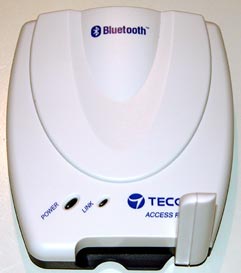|
There are even several software and operating system solutions to
connect a T3 to the internet, using an existing
LAN infrastructure. There's Mocca PPP and WinXP (prof.) has
all on board, to setup a quite weird serial BT connection with a
T3. I even found a PDF describing that in detail.
But all these solutions are involving a PC which has to be up and
running. Now, a PDA is no real 'internet machine' and alot of
pages are still a pain to browse, even with the high-res screens. But
one real useful 'internet job' for a PDAs is reading your
favourite news sites and I love doing that late evening,
especially when my PCs are finally shut down :). The only hardware
running 24 hours in my house are the LAN components like switches,
routers and APs. So I wanted a 'hardware' solution without
spending the ludicous $300-400 some companies want for their
Bluetooth access points. Frankly, I have no idea why that
BT radio would make an access point 4 times more expensive than
the same LAN functionality with an average 802.11b radio - rip
off! And finally I found my solution:
The Bluetooth Access Point TECOM BT3021. I
got it brandnew from a dealer on eBay and I payed 69 €, IMHO a very
reasonable price. I think the list price is much higher (~ 120.- €) and
the average street price seems to be around 90.- €. Anyway, the BT3021
is worth it. Not only does it support several BT protocols, it's also a
class 1 device good for up to 100 meter range. Although the T3 has only
a class 2 BT radio (10 meter), my experience with mixed class 1 and
class 2 units is still better than with two class 2 devices. And then,
you never know what you'll get tomorrow :). For example I also have a
LOOX 600 (not as a PDA <g>!) which has a class 1 BT module. The
range between the BT3021 and the LOOX is very good, actually the same
as all my 802.11 WLAN stuff. However, since an access point doesn't
have to conserve precious mobile power, it's never a mistake to have it
equipped with the 'power version' of Bluetooth. The unit itself is
quite small, about the size of a Tungsten and it's very easy to
install: Connect it to your LAN and power it up with the usual power
brick (supplied). For the first use, there's a nice tool supplied
called 'Locator'. It finds the AP in your LAN and allows to set the
most essential parameters to match your LAN setup (IP, netmask,
gateway). From that point on, you can handle all further settings with
any browser, since the BT3021 comes with a small web-interface HTTP
server. Two LEDs are showing that the BT3021 has power and is linked
(or not) to a client. Spartanic, but enough. Actually, you can find
much more info about the BT3021 on TECOMs site or in their 2 page PDF info flyer. Now,
as for the partnership between the 3021 and the T3, I have no exact
idea why it's working so well, I just know it does! I think in the
first place I still didn't fully understand PalmOS regarding these kind
of connections. Why for example is there always that confusing speed
and flow control setup (i.e. 115200 bps) when it connects to a 'Local
Network'? That's no serial connection, right?? Anyway, here's how the
T3 connects to the BT3021: Configure a new connection with any name
like 'local LAN' or such, connecting to the 'Local Network' via
'Bluetooth'. Set the details to 115200 bps, automatic flow. Then
configure a new network service with no user name, no password and use
the connection you just created ('local LAN'). Provided you specified
an IP range from your LAN address space in the BT3021 setup, the BT3021
supplies the Tungsten automatically with an IP and the DNS address. So
in the details of the network service on the Tungsten you just need to
check 'Query DNS' and 'IP address automatic'. Connection type is PPP
and I personally set the idle timeout to 'never' since I'm on a flat
rate, but that setting doesn't really matter for a successful
connection. That's it, ready to go! With
its several BT profiles, the BT3021 connects to about any
BT enabled device, so it can also be used to connect laptops or
other PCs. It's a bit confusing how many connections the BT3021 can
handle at the same time. The product flyer says 7, a little piece of
paper in the box says 2 only, in the setup you can specify 5 IPs for
the DHCP and I succeeded with 3 at the same time (I had no
more devices). But considering the maximum speed of Bluetooth
generally, too many connections are no good idea anyway. |

